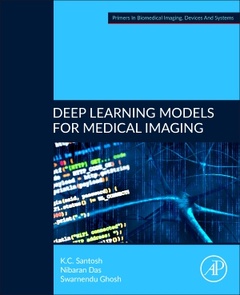Deep Learning Models for Medical Imaging Primers in Biomedical Imaging Devices and Systems Series
Langue : Anglais
Auteurs : Santosh KC, Das Nibaran, Ghosh Swarnendu

Deep Learning Models for Medical Imaging explains the concepts of Deep Learning (DL) and its importance in medical imaging and/or healthcare using two different case studies: a) cytology image analysis and b) coronavirus (COVID-19) prediction, screening, and decision-making, using publicly available datasets in their respective experiments. Of many DL models, custom Convolutional Neural Network (CNN), ResNet, InceptionNet and DenseNet are used. The results follow ?with? and ?without? transfer learning (including different optimization solutions), in addition to the use of data augmentation and ensemble networks. DL models for medical imaging are suitable for a wide range of readers starting from early career research scholars, professors/scientists to industrialists.
1. Introduction 2. Deep learning: a review 3. Deep learning models 4. Cytology image analysis 5. COVID-19: prediction, screening, and decision-making
Engineers and biomedical engineers, medical imaging researchers and graduate students Clinical researchers
Prof. KC Santosh is the Chair of the Department of Computer Science at the University of South Dakota (USD). Before joining USD, Prof. Santoshworked as a research fellow at the U.S. National Library of Medicine (NLM), National Institutes of Health (NIH). He was a postdoctoral research scientist at the LORIA research centre (with industrial partner, ITESOFT (France)). He has demonstrated expertise in artificial intelligence, machine learning, pattern recognition, computer vision, image processing and data mining with applications, such as medical imaging informatics, document imaging, biometrics, forensics, and speech analysis. His research projects are funded by
multiple agencies, such as SDCRGP, Department of Education, National Science Foundation, and Asian Office of Aerospace Research and Development. He is the proud recipient of the Cutler Award for Teaching and Research Excellence (USD, 2021), the President’s Research Excellence Award (USD, 2019), and the Ignite Award from the U.S. Department
Nibaran Das received his B.Tech degree in Computer Science and Technology from Kalyani Govt. Engineering College under KalyaniUniversity, in 2003. He received his M.C.S.E. degree from Jadavpur University, in 2005. He received his Ph.D. (Engg.) degree thereafter from Jadavpur University, in 2012. He joined J.U. as a lecturer in 2006. His areas of current research interest are OCR
of handwritten text, optimization techniques, image processing, and deep learning. He has been an editor of Bengali monthly magazine Computer Jagat since 2005.
Swarnendu Ghosh is an Assistant Professor at Adamas University in the department of Computer Science and Engineering. He received his B.Tech degree in Computer Science and Engineering from West Bengal University of Technology, in 2012. He received his Masters in Computer Science and Engineering from Jadavpur University, in 2014. He has been a doctoral fellow under the Erasmus Mundus Mobility with Asia at University of Evora, Por
multiple agencies, such as SDCRGP, Department of Education, National Science Foundation, and Asian Office of Aerospace Research and Development. He is the proud recipient of the Cutler Award for Teaching and Research Excellence (USD, 2021), the President’s Research Excellence Award (USD, 2019), and the Ignite Award from the U.S. Department
Nibaran Das received his B.Tech degree in Computer Science and Technology from Kalyani Govt. Engineering College under KalyaniUniversity, in 2003. He received his M.C.S.E. degree from Jadavpur University, in 2005. He received his Ph.D. (Engg.) degree thereafter from Jadavpur University, in 2012. He joined J.U. as a lecturer in 2006. His areas of current research interest are OCR
of handwritten text, optimization techniques, image processing, and deep learning. He has been an editor of Bengali monthly magazine Computer Jagat since 2005.
Swarnendu Ghosh is an Assistant Professor at Adamas University in the department of Computer Science and Engineering. He received his B.Tech degree in Computer Science and Engineering from West Bengal University of Technology, in 2012. He received his Masters in Computer Science and Engineering from Jadavpur University, in 2014. He has been a doctoral fellow under the Erasmus Mundus Mobility with Asia at University of Evora, Por
- Provides a step-by-step approach to develop deep learning models
- Presents case studies showing end-to-end implementation (source codes: available upon request)
Date de parution : 09-2021
Ouvrage de 170 p.
19x23.4 cm
Thème de Deep Learning Models for Medical Imaging :
© 2024 LAVOISIER S.A.S.


